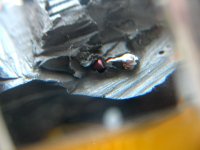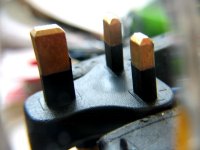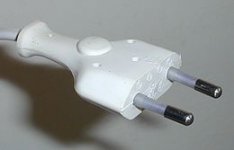Good reasons for dumping the Yaqin power lead if you live in the UK - yes they come with many Yaqin models and are seriously dangerous! Please Yaqin Design Engineers if you read this - CHANGE THE DESIGN!
The first picture shows the Live wire (Brown) soldered, without a fuse, directly to the the the - wait for it - the N or Neutral Pin!
The Neutral wire (Blue) is soldered, without a fuse, directly to the L or Live Pin!
The wire is extremely thin, you would want to have a 1 Amp maximum fuse in the plug top if only you could fit one.
The second picture shows the dreaded sleeved Earth or Grounding Pin. There is no guarantee that a sleeved Earth Pin will actually make a ground connection in a standard UK power socket. The Earth Pin must be a solid pin connection all the way from tip to plug body!
ONLY the L and N Pins MUST, be sleeved.
Please Yaqin - in the UK all of our power sockets are fed by a 30 Amp Ring Main system. It is the fusible plugs that make the whole system safe. With your present power lead, a short circuit in the equipment it feeds will result in a 100% fire due to the thin cable now taking 30 Amps and will without doubt light up very quickly!
The Green Ground wire (Which should be Yellow with a Green stripe) is very thin and must be able to withstand a fault current to blow the fuse, if only one was fitted.
This is such a dangerous cable that it should be cut into pieces and thrown away without any further thought.
For our friends in the States, if you use this cable you would normally connect the Brown wire to where you would fit the Black wire (Live or Hot wire).
The Blue wire should go to where you would fit the White wire (Neutral).
At least the socket end appears to be wired the right way round with the Brown wire going to L but given the general build standard, it may be wise to check this out with your multimeter or continuity tester.
Better still, bin the cable anyway as the wire thickness and general quality is way below par.
Keep Safe!
The first picture shows the Live wire (Brown) soldered, without a fuse, directly to the the the - wait for it - the N or Neutral Pin!
The Neutral wire (Blue) is soldered, without a fuse, directly to the L or Live Pin!
The wire is extremely thin, you would want to have a 1 Amp maximum fuse in the plug top if only you could fit one.
The second picture shows the dreaded sleeved Earth or Grounding Pin. There is no guarantee that a sleeved Earth Pin will actually make a ground connection in a standard UK power socket. The Earth Pin must be a solid pin connection all the way from tip to plug body!
ONLY the L and N Pins MUST, be sleeved.
Please Yaqin - in the UK all of our power sockets are fed by a 30 Amp Ring Main system. It is the fusible plugs that make the whole system safe. With your present power lead, a short circuit in the equipment it feeds will result in a 100% fire due to the thin cable now taking 30 Amps and will without doubt light up very quickly!
The Green Ground wire (Which should be Yellow with a Green stripe) is very thin and must be able to withstand a fault current to blow the fuse, if only one was fitted.
This is such a dangerous cable that it should be cut into pieces and thrown away without any further thought.
For our friends in the States, if you use this cable you would normally connect the Brown wire to where you would fit the Black wire (Live or Hot wire).
The Blue wire should go to where you would fit the White wire (Neutral).
At least the socket end appears to be wired the right way round with the Brown wire going to L but given the general build standard, it may be wise to check this out with your multimeter or continuity tester.
Better still, bin the cable anyway as the wire thickness and general quality is way below par.
Keep Safe!
Attachments
They are not allowed to be sold in the UK with this type of power cable. It is against our safety standards and our Trading Standards Officers will prosecute the traders selling them and destroy the dangerous equipment.
But are they sold by a legitimate legal importer? Or directly online from China?
Not sure about the UK, but in the US if I buy something online from outside the country, I am the legal importer, so it is my responsibility.
I seriously doubt that they would comply with safety standards in the US or EU either. Probably not ROHS either.
Really? You guys expect a cheap Chinese-brand tube amp to comply with UK safety regulations?
There are probably things inside the chassis that are more frightening than the non-compliant power cord.
You get what you pay for.
This is very true. In my Ming-Da there was a non X2 rated capacitor across the mains switch. It was the cheap dark brown type. It shorted and the amp would not turn off. I am lucky it didn't go up in flames!
I have tested one of those mains leads and they are rated at 1 amp maximum.
Even the wires inside the cable are flimsy. They are OK for wiring inside a chassis but not for anything that has movement.
The testing I did was written up at the time. You may need to join the forum to see it though.
• View topic - Re: Electricals purchased via the internet. Safety.
Even the wires inside the cable are flimsy. They are OK for wiring inside a chassis but not for anything that has movement.
The testing I did was written up at the time. You may need to join the forum to see it though.
• View topic - Re: Electricals purchased via the internet. Safety.
As a child my older relatives would say crazy things to me:
-Don't lean against the car door, it can pop open!
-Don't touch that, it will shock you!
...and so on. Modern developed nations did not have issues with products at that time, they did in the early 20th C.
Chinese production is now similar.
I live in Western China.
When I buy something,a moto, bicycle, electronics, it requires a rebuild, retorque, repaint, and check of parts, fit, finish, etc. It's not the same as purchasing a finished good in the EU. Appliances are measured for issues. I do this for friends as well.
Pocket bikes require a more or less strip down and rebuild and re-hardware from the ground up including a carb modification. This is *before* break-in periods.
Many - *many* - consumer electronics from and within China have low-level DC or AC on the chassis at all times. This can be measured (1-3V) and felt at times. 3 DAC, two amps, my refrigerator, to name a few.
I have all of my appliances on ground interrupts and I treat anything electronic as a potential high voltage to ground situation.
You engineers would throw fits if I posted photos of residential distribution transformers here. They are at eye-level on the sidewalk, unsecured, panels are open, all metal is heavily rusted and corroded, wires draped and hanging all over. If one had the desire, it would be trivial to place ones hands inside the junction box and have a 1 on 1 with some high amperage municipal 240v to kVA level.
I treat all metal structures for these as though they are live and walk around.
This is changing as tall transmission lines are installed in cities and the power is raised 25+metres up.
I walk around those metal poles, too... ;-0
..and then there was that 10cm gas main break 2 years back...
-Don't lean against the car door, it can pop open!
-Don't touch that, it will shock you!
...and so on. Modern developed nations did not have issues with products at that time, they did in the early 20th C.
Chinese production is now similar.
I live in Western China.
When I buy something,a moto, bicycle, electronics, it requires a rebuild, retorque, repaint, and check of parts, fit, finish, etc. It's not the same as purchasing a finished good in the EU. Appliances are measured for issues. I do this for friends as well.
Pocket bikes require a more or less strip down and rebuild and re-hardware from the ground up including a carb modification. This is *before* break-in periods.
Many - *many* - consumer electronics from and within China have low-level DC or AC on the chassis at all times. This can be measured (1-3V) and felt at times. 3 DAC, two amps, my refrigerator, to name a few.
I have all of my appliances on ground interrupts and I treat anything electronic as a potential high voltage to ground situation.
You engineers would throw fits if I posted photos of residential distribution transformers here. They are at eye-level on the sidewalk, unsecured, panels are open, all metal is heavily rusted and corroded, wires draped and hanging all over. If one had the desire, it would be trivial to place ones hands inside the junction box and have a 1 on 1 with some high amperage municipal 240v to kVA level.
I treat all metal structures for these as though they are live and walk around.
This is changing as tall transmission lines are installed in cities and the power is raised 25+metres up.
I walk around those metal poles, too... ;-0
..and then there was that 10cm gas main break 2 years back...
Last edited:
The first picture shows the Live wire (Brown) soldered, without a fuse, directly to the the the - wait for it - the N or Neutral Pin!
The Neutral wire (Blue) is soldered, without a fuse, directly to the L or Live Pin!
They must have thought something like "Blue must be the hot, that's the color of the sky, where you see high voltage wires. And brown is the color of the Earth, soil is brown, so it must be the neutral".
Most places in the world do not have fuses in the plug. Most outlets are protected by a 15A fuse or circuit breaker in a distribution panel. Yaqin may not have realized that UK does it different. But a line cord with wires only able to handle 1A would still be a hazard in the USA, as one of our 15A circuit breakers likely would not trip if it shorted at the far end. Our minimum wire size for line cords is AWG 18 gauge.
Do hardware shops in the UK sell replacement plugs with replaceable fuses that you could fit 1A fuses in? Looks like the minimum you need do is to cut off the Yaqin plug and replace it with a safe one.
Honestly, errors such as swapping hot/cold/ground are far less common than one would think based on this thread.
One does, however, have to be very proactive. Even Chinese consumers won't stand for hot wired chassis in new products.
Far more common are cap, Opamp or other component failures (those *do* happen often) and when ordering inside China ~2% of your orders won't ever reach you.
One does, however, have to be very proactive. Even Chinese consumers won't stand for hot wired chassis in new products.
Far more common are cap, Opamp or other component failures (those *do* happen often) and when ordering inside China ~2% of your orders won't ever reach you.
Wa2,
You have one question, I'm not sure whether the rest is comment or question.
The BS1362 fuse fits inside the BS1363 plug top.
That is the standard to be found in domestic installations.
This standard is also used in commercial and industrial installations where "normal" 240Vac is distributed.
There are special outlets that do not allow a "normal" BS1363 plug top to fit.
The BS1362 fuses are available in a wide range of values.
1A, 2A, 3A, 5A, 7A, 10A and 13A.
These are supplemented by the "fuse" in the distribution board.
They can also be supplemented by equipment fuse/s.
You have one question, I'm not sure whether the rest is comment or question.
The BS1362 fuse fits inside the BS1363 plug top.
That is the standard to be found in domestic installations.
This standard is also used in commercial and industrial installations where "normal" 240Vac is distributed.
There are special outlets that do not allow a "normal" BS1363 plug top to fit.
The BS1362 fuses are available in a wide range of values.
1A, 2A, 3A, 5A, 7A, 10A and 13A.
These are supplemented by the "fuse" in the distribution board.
They can also be supplemented by equipment fuse/s.
I emailed an ebay seller and asked;
"Has the power cable got the BS1363 kite mark on the plug" the reply was;
The power cable provide is fully compatible in UK
- bingobingo515
That doesn't really mean anything. The 'plug' may fit but might not be up to standard.
The English is not up to much either!
"Has the power cable got the BS1363 kite mark on the plug" the reply was;
The power cable provide is fully compatible in UK
- bingobingo515
That doesn't really mean anything. The 'plug' may fit but might not be up to standard.
The English is not up to much either!
...
3A, 5A and 13A are sold widely.
The 1 amp cable is a problem.
Well, change out the cable and use a 3A fuse. And follow the color code with the wires.
- Status
- This old topic is closed. If you want to reopen this topic, contact a moderator using the "Report Post" button.
- Home
- Amplifiers
- Tubes / Valves
- Safety Alert - UK Yaqin users


